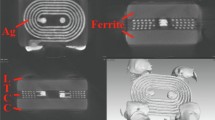Abstract
The residual strain in pure printed circuit boards (PCBs) and PCBs with Cu-plated holes has been obtained by measurement of the temperature dependence of their dilatational characteristics in the x, y, and z directions up to 240°C. Shrinkage in all directions was observed for all samples of both materials in the first thermal cycle. No permanent length changes were observed in the second or subsequent thermal cycles. The residual strain was determined from the difference in relative elongation between the first and second thermal cycles. Relaxation of residual strain occurred only in the first thermal cycle, as a thermally activated process. The highest value of relaxed residual strain was found in the z direction for both materials. Relaxation of residual strain in the z direction of the pure PCB occurred only in the negative strain range, whereas relaxation of the PCB with Cu-plated holes occurred in both the positive and negative strain ranges. The relaxation of the positive strain in the PCB with Cu-plated holes in the z direction implies that this part of the PCB was under pressure during its preparation. This relaxation is a consequence of the high coefficient of thermal expansion of PCB laminate in this direction, which can also lead to cracks in Cu holes when the material is heated above the glass-transition temperature.
Similar content being viewed by others
References
K. Dušek and A. Rudajevová, J. Mater. Sci. Mater. Electron. 28, 1070 (2017).
C.A. Smith, Polym. Test. 52, 234 (2016).
H. Qi, S. Ganesan, and M. Pecht, Microelectron. Reliab. 48, 663 (2008).
S. Belyakov, H.V. Atkinson, and S.P.A. Gill, J. Electron. Mater. 39, 1295 (2010).
T. Kim, J. Lee, Y. Kim, J.-M. Kim, and Z. Yuan, Mater. Trans. 50, 2695 (2009).
A. Géczy, M. Fej\Hos, L. Tersztyánszky, A. Kemler, and A. Szabó, in Proceedings of 2014 37th International Spring Seminar on Electronics Technology (IEEE, 2014), pp. 215–220.
A. Geczy, M. Fejos, and L. Tersztyánszky, Solder. Surf. Mt. Technol. 27, 61 (2015).
G.A. Schuerink, M. Slomp, W.W. Wits, R. Legtenberg, and E.A. Kappel, Procedia CIRP 9, 55 (2013).
D. Goval, H. Azimi, K.P. Chong, and M.-J. Lii, in Reliability Physics Symposium, 1997, 35th Annual Proceedings (IEEE, 1997), pp. 129–135.
G. Subbarayan, K. Ramakrishna, and B.G. Sammakia, J. Electron. Packag. 119, 260 (1997).
K. Ramakrishna, G. Subbarayan, and B. G. Sammakia, in Proceedings of First ASMEJSME Joint Electronic Packaging Conference (EEP, 1992), pp. 9–12.
A. Salahouelhadj, M. Martiny, S. Mercier, L. Bodin, D. Manteigas, and B. Stephan, Microelectron. Reliab. 54, 204 (2014).
H.R. Chou, A.P. Singh, M. Saravanan, and B. Varaprasad, IEEE Trans. Compon. Packag. Manuf. Technol. 6, 926 (2016).
M. Hart, in Microelectronics Packaging Conference EMPC 2015 European (IEEE, 2015), pp. 1–5.
E. Suhir, R. Ghaffarian, and J. Nicolics, J. Mater. Sci. Mater. Electron. 26, 10062 (2015).
S. Chung, S. Oh, T. Lee, and M. Park, in Thermal, Mechanical and Multi-physics Simulation and Experiments in Microelectronics and Microsystems, Eurosime 2014 15th International Conference on (IEEE, 2014), pp. 1–5.
M. Weinhold and G. Yen, Circuit World 29, 24 (2003).
A. Rudajevová, J. Prokeš, and M. Varga, Chem. Pap. 71, 393 (2017).
M. Mengel, J. Mahler, and W. Schober, J. Reinf. Plast. Compos. 23, 1755 (2004).
F. Su, R. Mao, J. Xiong, K. Zhou, Z. Zhang, J. Shao, and C. Xie, Microelectron. Reliab. 52, 1189 (2012).
L.-N. Ji, Y. Gong, and Z.-G. Yang, Microelectron. Reliab. 50, 1163 (2010).
Author information
Authors and Affiliations
Corresponding author
Rights and permissions
About this article
Cite this article
Rudajevova, A., Dušek, K. Residual Strain in PCBs with Cu-Plated Holes. J. Electron. Mater. 46, 6984–6991 (2017). https://doi.org/10.1007/s11664-017-5714-3
Received:
Accepted:
Published:
Issue Date:
DOI: https://doi.org/10.1007/s11664-017-5714-3




